Your sun-powered oven typically needs 30-90 minutes to preheat, depending on the season and weather conditions. In summer, you'll reach cooking temperatures around 300°F in about 30 minutes, while winter preheating can take up to 90 minutes to hit 350°F. For best results, start preheating between 11 AM and 3 PM, with peak efficiency occurring from 1-3 PM. You'll want to position your oven in a shadow-free, wind-protected spot and adjust its angle every 15-30 minutes. Proper insulation and sun tracking techniques can greatly boost your preheating success and overall cooking performance.
Optimal Preheating Times
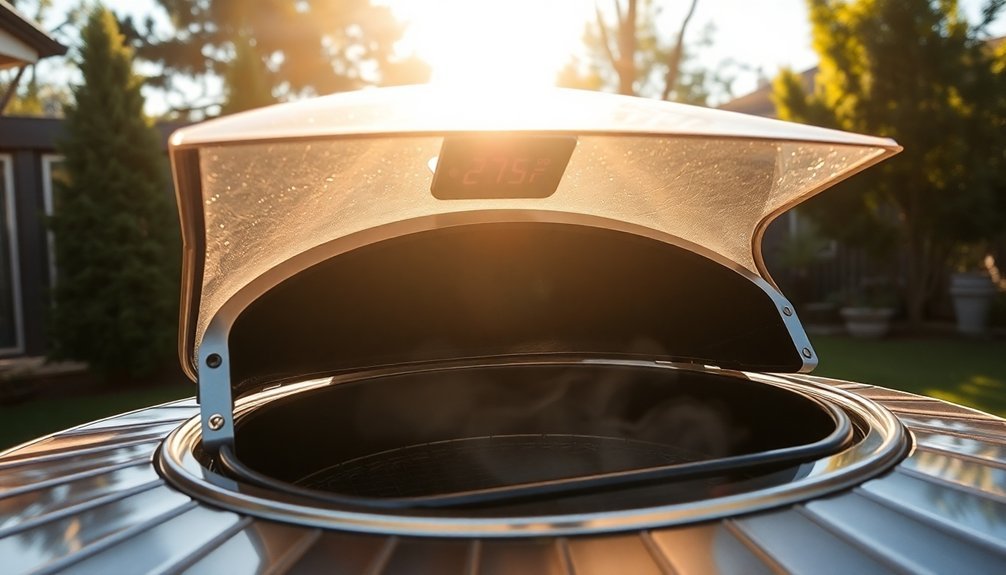
Three key components determine the ideal preheating time for your solar oven: available sunlight, atmospheric conditions, and the oven's design.
You'll want to preheat your solar oven for at least 30 minutes before cooking, allowing it to reach temperatures up to 400 degrees Fahrenheit in favorable conditions. During this time, you can leave the oven empty or place an empty pot inside. Relying on visual cooking cues rather than thermometer readings can help you determine when preheating is complete.
The efficiency of your oven's reflectors and insulation will greatly impact how quickly it heats up.
To maximize preheating effectiveness, adjust your oven every 30 minutes to track the sun's movement. If you're cooking at high altitudes, you might achieve faster preheating times due to less atmospheric interference.
Using additional reflective materials like aluminum foil can help concentrate more solar energy and speed up the process.
Seasonal Adjustments for Preheating
Your preheating approach needs to shift greatly between summer and winter, with summer allowing for quick 30-minute preheats during peak hours of 10 AM to 2 PM, while winter requires up to 90 minutes between 11 AM and 3 PM.
You'll need to adjust your solar oven's angle more frequently in winter due to lower sun positions, whereas summer's high sun angles require minimal repositioning. A properly insulated oven can still reach 350°F in winter despite the cold weather.
Weather conditions will greatly impact your preheating success, so you'll want to choose clear, calm days and use additional insulation during colder months.
Summer Vs Winter Timing
When preheating your sun-powered oven, you'll need to account for significant seasonal differences in timing and temperature potential.
In summer, you can achieve temperatures up to 350°F within 20-30 minutes, with cooking possible for up to 13 hours daily.
Winter presents more challenges, with temperatures rarely exceeding 300°F and cooking limited to about 5 hours per day. Using a solar box cooker will provide better insulation and heating efficiency compared to other types during cold months.
- Summer preheating maintains consistent temperatures with 30-minute alignments, while winter requires more frequent adjustments due to the sun's lower position.
- You'll need booster panels and insulated containers in winter to enhance efficiency and retain heat.
- Plan for similar preheating times year-round (20-30 minutes), but expect lower maximum temperatures and shorter cooking windows during winter months.
Sunlight Angle Considerations
Proper alignment with the sun's angle plays an essential role in preheating your solar oven effectively. During winter months, you'll need to make more frequent adjustments since the sun sits lower on the horizon.
Use the E-Z Sun-track indicators on the glass door to maintain prime positioning – when sunlight passes through the top hole, you should see a bright dot centered over the bottom hole.
Adjust your oven's elevation using the T-shaped alignment leg to match the sun's seasonal angle. For maximum stability, especially on windy days, secure the leg's base with wire stakes. The oven can reach 300°F in 20 minutes when properly positioned in strong sunlight.
You can also add booster panels to enhance sun concentration and speed up preheating during challenging seasons. Remember to realign your oven every 30 minutes to maintain the ideal temperature for cooking.
Weather Impact on Preheating
Successful preheating of a sun-powered oven depends heavily on weather conditions and seasonal changes. During summer months, you'll find preheating times are shorter, with temperatures reaching 300°F in about 20 minutes.
However, winter requires longer preheating periods due to less direct sunlight, and you'll need to adjust your oven's angle more frequently.
- Spring and fall cooking requires regular angle adjustments and sun tracking to maintain ideal temperatures.
- Additional reflectors or booster panels can help speed up preheating during colder seasons.
- Sheltering your oven from strong winds will improve preheating efficiency year-round.
For best results in any season, preheat your oven for at least 30 minutes before cooking, and realign it every half hour to maintain maximum temperature.
Using proper insulation materials like feathers or cotton balls will help retain heat regardless of external conditions.
Morning Vs Afternoon Heat Buildup
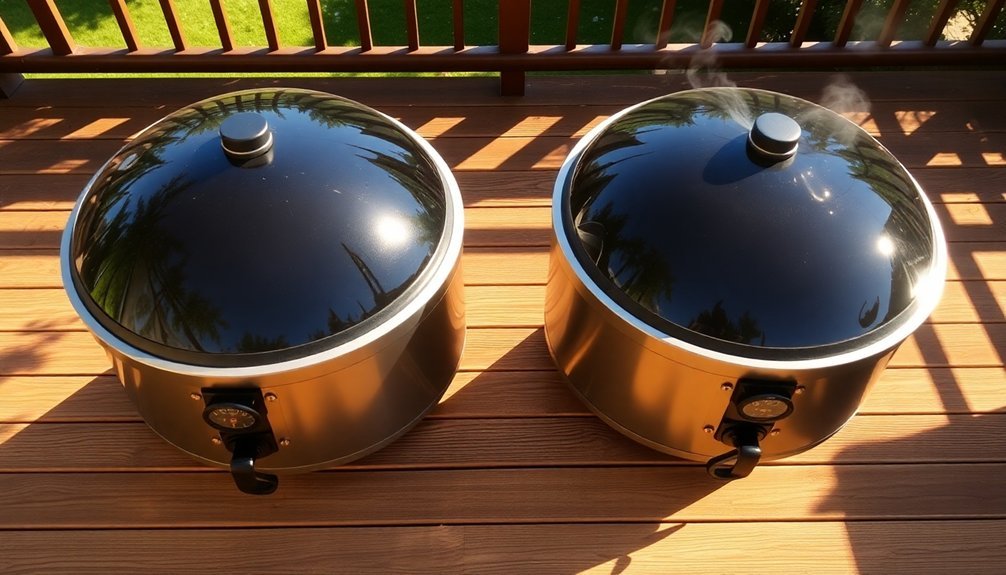
Understanding the difference between morning and afternoon heat buildup can greatly impact your solar cooking success. You'll want to adjust your cooking strategy based on the time of day, as morning temperatures build more slowly and require frequent oven adjustments due to the sun's lower position.
| Time | Temperature | Adjustments |
|---|---|---|
| Morning | Lower (slower buildup) | Every 15-30 mins |
| Mid-day | Moderate | Every 30-45 mins |
| Early PM | High (300-350°F) | Every 45-60 mins |
| Mid PM | Peak efficiency | Minimal |
| Late PM | Gradually decreasing | As needed |
Afternoon cooking offers ideal conditions with higher temperatures and more direct sunlight. You'll find your solar oven reaches peak efficiency between 1-3 PM, requiring fewer adjustments while maintaining consistent heat. Remember to rely on both your thermometer and sensory cues to gauge food doneness throughout the day.
Temperature Goals Before Cooking
Now that you're familiar with daily heat patterns, reaching the right temperature before adding food will make or break your solar cooking experience. Your sun oven needs to hit at least 180°F to cook effectively, but you'll want to aim for 300-375°F for best results.
On clear days, you can achieve these temperatures in about 20 minutes of preheating.
For consistently great results, make sure to:
- Align your oven directly with the sun before preheating, ensuring the shadow falls straight behind
- Keep the glass door closed and latched during the entire preheating process
- Clean reflectors and glass thoroughly to maximize heat absorption
Use a food thermometer to verify your oven's temperature before adding food.
With proper alignment and maintenance, you can reach temperatures up to 400°F on perfect sunny days.
Weather Impact on Preheating Duration
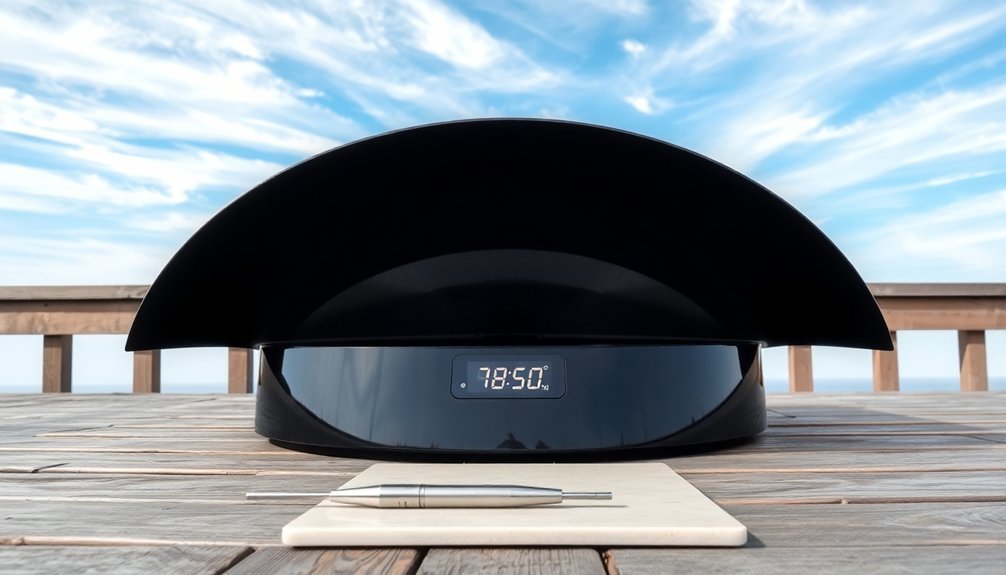
Your preheating time will double or triple on cloudy days, so it's smart to start earlier and use extra insulation to retain heat.
When clouds are dense, you'll need to adjust the oven's position more frequently to catch available sunlight and maintain temperature.
On clear days, you can expect normal preheating times of 30-45 minutes, but overcast conditions may require up to 2 hours to reach cooking temperatures.
Cloudy Day Preheating Tips
When clouds roll in, preheating your sun-powered oven requires extra attention and patience. You'll need to extend your preheating time since cloud cover reduces the direct sunlight reaching your oven.
While cloudy conditions may slow down the process, your oven can still reach food-safe temperatures above 180°F with proper setup and insulation.
To maximize your oven's performance on cloudy days:
- Position your oven in a south-facing, sheltered spot and adjust it throughout the day to track the sun
- Line your oven with dark-colored cookware and reinforce insulation using newspapers, feathers, or cotton balls
- Add reflective surfaces like aluminum foil or mirrors to capture and direct more solar energy
Don't let clouds discourage you – with these adaptations, you can still achieve effective preheating for successful solar cooking.
Clear vs. Overcast Times
Dramatic differences in preheating times emerge between clear and overcast conditions for sun-powered ovens. On clear days, you'll reach 300°F in about 20 minutes when you position your oven correctly during peak hours (11 AM to 3 PM).
You'll need to realign the oven every 30 minutes to maintain temperatures between 300-375°F. Your preheating success depends on proper positioning.
Place your oven in a shadow-free spot that's protected from wind, and guarantee you're using dark-colored cookware to maximize heat absorption. While outside temperature has only a moderate effect, good insulation is vital.
You can boost efficiency with materials like feathers, cotton balls, or newspaper for insulation, and reflective surfaces like aluminum foil to direct more sunlight into your oven.
Insulation During Preheat Phase
Proper insulation plays an essential role in preheating your sun-powered oven efficiently.
You'll want to line the sides with rolled newspaper or cotton padding, while covering the interior surfaces with aluminum foil to reflect heat.
Place black construction paper on the bottom to absorb sunlight, and seal the top with plastic wrap to prevent heat loss through convection.
For ideal preheating performance:
- Layer your insulation materials strategically – sides, bottom, and interior – to create a heat-trapping environment
- Verify your oven is completely airtight by checking all seals and corners
- Cover the flap's interior with aluminum foil to maximize sunlight reflection into the cooking chamber
These insulation steps will help your oven heat up faster and maintain consistent temperatures during the preheat phase, leading to better cooking results.
Sun Tracking While Preheating
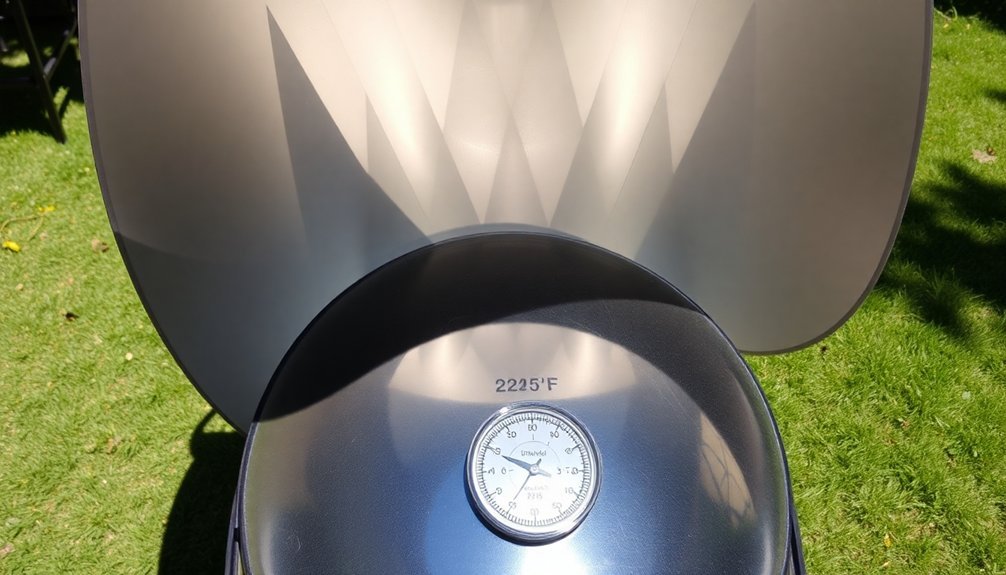
An automated sun tracking system maximizes your solar oven's preheating efficiency. While preheating, the solar-powered motor will rotate your reflector about half an inch every five minutes to maintain perfect alignment with the sun. You'll notice the motor automatically stops when the oven faces directly into the sunlight.
| Time Period | Rotation | What You'll See |
|---|---|---|
| 5 minutes | 0.5 inch | Motor adjusts slightly |
| 1 hour | 6 inches | Gradual movement |
| 3 hours | 90 degrees | Complete quarter turn |
You won't need to manually adjust the tracking during preheating, as the servo and panel configuration handles this automatically. If your oven moves past the sun's position, don't worry – the system will reverse direction to recenter itself. You can make fine adjustments to the elevation using the rod and u-bolt mechanism if needed.
Monitoring Heat Retention
Successfully monitoring heat retention requires several key components working together in your sun-powered oven.
You'll need to track temperatures using thermocouples and data loggers while ensuring your insulation and glazing systems are performing efficiently.
Install multiple layers of insulation, such as crumpled newspaper or rockwool, and use double-paned glass with anti-reflective coating to maintain consistent heat levels.
- Use a mobile app to monitor real-time temperature data and receive alerts when heat levels drop
- Position reflector panels strategically to concentrate solar energy and adjust angles as the sun moves
- Apply dark materials to interior surfaces to maximize solar radiation absorption up to 95%
Remember to regularly calibrate your temperature sensors and account for environmental factors like wind and cloud cover when analyzing your oven's heat retention performance.
Solar Position and Preheat Time
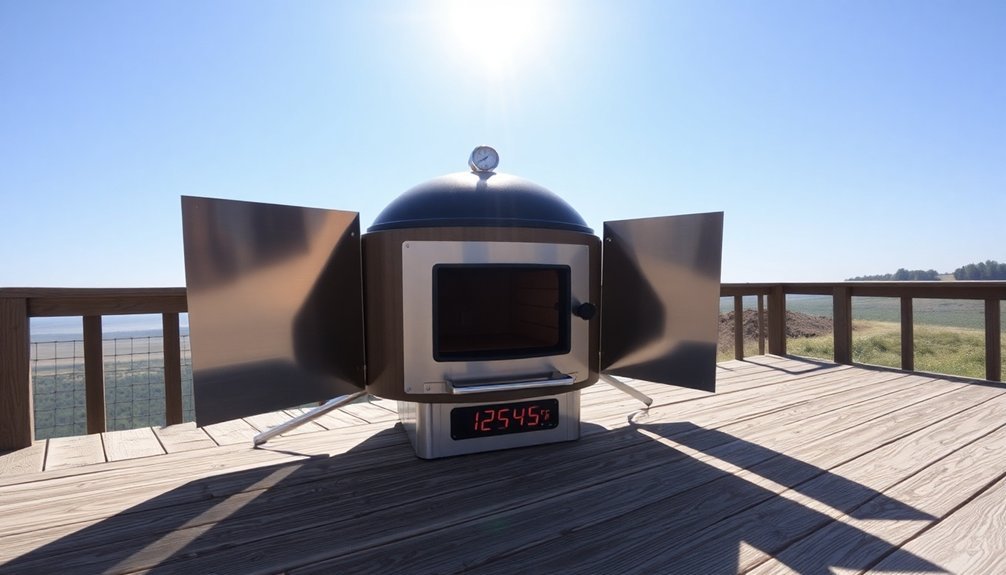
Building on effective heat retention practices, understanding solar positioning and timing is key to preheating your sun-powered oven.
You'll achieve ideal preheating between 11:00 am and 3:00 pm when the sun is directly overhead. Start preheating as early as 10:00 am during peak seasons to guarantee your oven reaches cooking temperature.
You'll need to track the sun more frequently during winter months due to its lower position, while summer allows for less frequent adjustments. The sun's angle affects your oven's efficiency, so you'll want to adjust its orientation accordingly.
If you're cooking on cloudy days, expect longer preheating times and plan accordingly. Remember, your location matters – if you're closer to the Equator, you'll enjoy more sunlight and extended cooking hours compared to northern regions.
Frequently Asked Questions
Can I Preheat My Solar Oven on a Covered Patio?
You shouldn't preheat your solar oven on a covered patio. The cover blocks essential direct sunlight, making preheating inefficient. Instead, find a spot with full sun exposure for ideal heating performance.
What Happens if I Forget to Close the Reflector Panels While Preheating?
If you forget to close the reflector panels, your solar oven won't reach proper cooking temperatures. You'll lose significant heat and sunlight concentration, making preheating take much longer or fail to achieve needed temperatures.
Should I Place an Empty Pot Inside While Preheating?
Yes, you'll want to place an empty pot inside while preheating. It helps your solar oven heat up uniformly and lets you monitor the internal temperature better. Plus, it'll reduce your overall cooking time.
Does the Color of My Cookware Affect Preheating Efficiency?
Yes, your cookware's color greatly affects preheating efficiency. You'll get better results with dark-colored pots and pans since they absorb heat more effectively than light or reflective ones. Consider covering shiny cookware with dark cloths.
Can Preheating Damage the Oven's Insulation Materials Over Time?
If you're using your solar oven correctly, preheating won't damage insulation. However, you'll want to avoid extremely high temperatures and monitor cooking times, as prolonged exposure to excessive heat can gradually degrade insulation materials.
In Summary
You'll need to allow 30-45 minutes for your solar oven to reach cooking temperatures, but don't forget to adjust this time based on season and weather. Keep tracking the sun's position and monitor your oven's heat retention carefully. During winter months or on partly cloudy days, you'll want to add 15-20 minutes to your preheat time. Remember, proper preheating is essential for successful solar cooking.

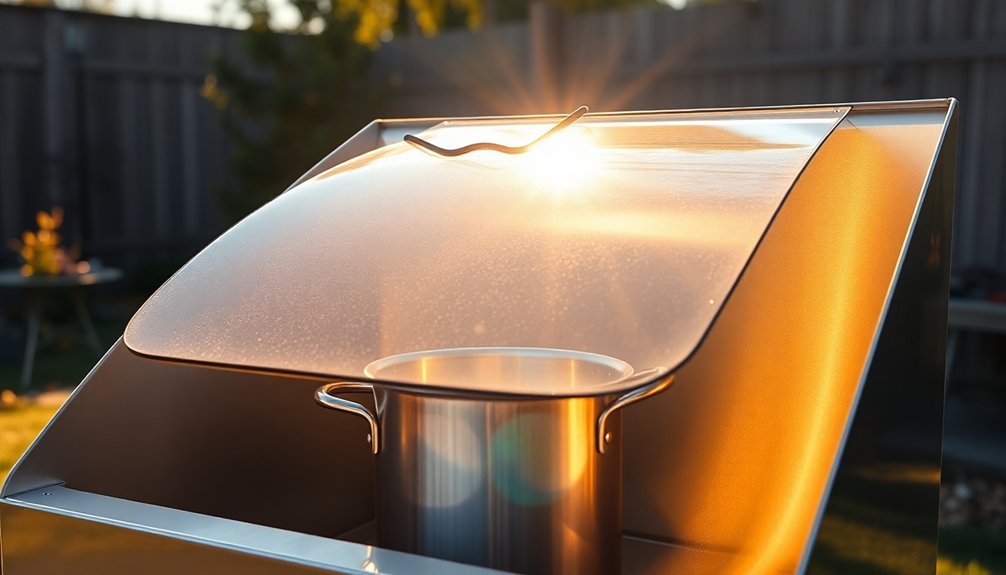



Leave a Reply